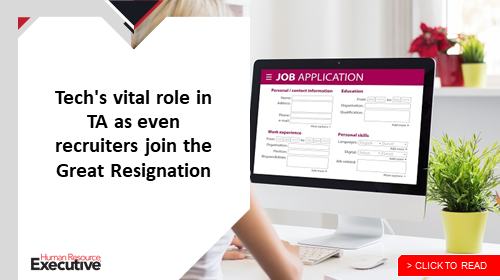Last year was a record-setting year for HR technology in both venture capital investment and adoption. WorkTech tracked a new high of $17.9 billion in global HR technology investment across 374 deals while spending increased aggressively. And conditions in early 2022 look ripe for even more acceleration of HR tech adoption and investment. Here’s a look at two reasons for the acceleration along with a dive into what type of technologies are headed your way.
1. Despite inflation and a lack of available talent, the economy grows.
While today’s headlines consistently focus on inflation, that doesn’t seem to be impacting the job market in the foreseeable future. The Federal Reserve has a median projection for real Gross Domestic Product growth at a healthy 3.7% and a median forecast for unemployment of 3.9%. The unemployment forecast is close to what many economists would consider “full employment,” even considering adjustments for those who became “long term unemployed” during the pandemic. The impact isn’t just on our ability to find and hire new talent but also contributes to the environment driving the “Great Resignation.” Workers are reportedly reevaluating their priorities while studies report rising cases of employee burnout as workday hours have increased along with work-related stress. Employers respond by rethinking everything from their recruiting methods to workforce models, employee wellness, benefits, retention strategies and more.
2. The Mother of Invention.
 The current slate of challenges, shared by businesses of all sizes, puts HR in the lead and in the spotlight. HR has the daunting task of transforming workplace and workforce strategy and execution through sustained uncertainty and change and doing it all in an economy fueling hyper-growth for many. That makes technology innovation the necessity for HR now, next, and well into the future.
The current slate of challenges, shared by businesses of all sizes, puts HR in the lead and in the spotlight. HR has the daunting task of transforming workplace and workforce strategy and execution through sustained uncertainty and change and doing it all in an economy fueling hyper-growth for many. That makes technology innovation the necessity for HR now, next, and well into the future.
And here’s the tech innovation that’s ready and racing into the workplace.
- Conversational AI: Businesses will move quickly to replace the people we can’t find and the experience we’ve struggled to provide with an interface that has been “in training” for this moment. A quick search on Indeed found that in the 14 days before I wrote this, 16,534 jobs for recruiters, 19,962 jobs in employee relations, and 314,329 jobs in human resources with some focus on benefits were posted by companies for locations the United States alone. People used to worry about conversational AI replacing jobs. Now, it’s a matter of it doing the jobs we don’t have the people for. And how can we provide a decent employee experience when we don’t have the people to be its stewards? Deloitte’s CFO survey listed talent as the biggest priority and simultaneously the most significant external threat. CFOs also expect to increase investments in automation across the business. Solutions like Olivia by Paradox in recruiting, onboarding and talent management, or Socrates AI across the post-hire employee lifecycle, or PandoLogic in employment branding, job advertising and candidate engagement have had AI algorithms training over the last several years, learning how to better engage with employees.
- Total talent: In this increasingly tight labor market, businesses will leverage freelance and contract workers even more. More workers chose independent work during the Great Resignation than ever before. The independent workforce grew by 34% in 2021 to 51 million workers. Seventeen million are working independently full time, up from 13.6 million. More than ever, businesses need an understanding of the talent available to them externally, internally, and for both full-time and contractual employment. A view of the total talent pool is relevant during workforce planning and as an ongoing requirement. People analytics providers like Talmetrix are helping employers understand the total addressable talent market and scenario plan and measure, not just headcount but on issues like diversity and equity. Solutions like Stoke Talent are bringing contract and freelance budgeting and hiring to the hiring manager’s desk while ensuring compliance for HR and finance. Watch staffing technology providers like Bullhorn, as it begins to empower staffing firms of all sizes to provide talent on demand via its acquisition of workforce management tech provider, Sirenum.
 Matching, selection and quality of hire: “Talent marketplaces,” the HR tech buzz phrase of the day, are a long way off—too long for most businesses to wait. Companies will focus on improving employee retention, making more quality hires and impacting workforce diversity with innovation available now. Businesses that get smarter about understanding and selecting candidates and employees for roles will have a competitive advantage. While a few companies are implementing talent marketplaces, the foundational work required in areas like competencies, skills lexicons, compensation, compliance, workflow, experience and more requires so much complex effort that I question whether we’ll see any meaningful adoption in this decade. Today, there are products in the market that address some significant points of opportunity for businesses looking to impact areas like quality of hire, retention and diversity. Talent sourcing solution SeekOut, for example, leverages AI to find and match candidates based on skills and inferences. Customers are beginning to leverage it internally for talent mobility while reporting improvements in diversity metrics. Searchlight is leveraging AI and behavioral science to improve candidate selection, onboarding and talent mobility with insights to help predict performance and fit while also working to mitigate unconscious bias in the process.
Matching, selection and quality of hire: “Talent marketplaces,” the HR tech buzz phrase of the day, are a long way off—too long for most businesses to wait. Companies will focus on improving employee retention, making more quality hires and impacting workforce diversity with innovation available now. Businesses that get smarter about understanding and selecting candidates and employees for roles will have a competitive advantage. While a few companies are implementing talent marketplaces, the foundational work required in areas like competencies, skills lexicons, compensation, compliance, workflow, experience and more requires so much complex effort that I question whether we’ll see any meaningful adoption in this decade. Today, there are products in the market that address some significant points of opportunity for businesses looking to impact areas like quality of hire, retention and diversity. Talent sourcing solution SeekOut, for example, leverages AI to find and match candidates based on skills and inferences. Customers are beginning to leverage it internally for talent mobility while reporting improvements in diversity metrics. Searchlight is leveraging AI and behavioral science to improve candidate selection, onboarding and talent mobility with insights to help predict performance and fit while also working to mitigate unconscious bias in the process.- Whole employee solutions: The pandemic has made business leaders rethink their relationship with workers while workers reevaluate everything about work. Companies that understand a Great Reconsideration precedes the Great Resignation quickly find ways to support the whole employee. Whole employee approaches are happening across pay, benefits, culture, engagement and more. Enterprises that hire and pay remote workers globally with solutions like Immedis expand their available talent pool while remaining compliant and offering more geographic mobility to their teams. Applications focused on mental wellness, like Unmind, bring technology powered by clinical psychology into the workplace, helping employees and organizations thrive. Solutions like Huler allow employees to control their digital experience at work. It will enable employees to blend or bifurcate their personal and professional digital experiences, giving them control of when they’re on or off. Startups like Billion Minds allow employees to track and manage their personal and professional goals and tasks in one place, gaining control of the overwhelming aspects of both. And new tools like Shaka help employees make the connections they used to make in a physical office from the confines of their remote workstation.
Overall, we’re seeing strong alignment between what HR leaders say they’re focused on and what the HR technology innovation pipeline is producing in 2022. Challenges presented by the COVID pandemic are daunting. Still, HR has risen to the challenge, transforming itself and the future of work with innovative new approaches and technology to support it. As we look toward the rest of 2022, we expect more innovation and potentially even more investment as the future of work is coming at us faster than ever.
To learn more, join me at 4:45 pm ET on March 2 for my keynote at the HR Tech Virtual Conference titled “HR Tech for 2022 and Beyond.” Click here to register.

